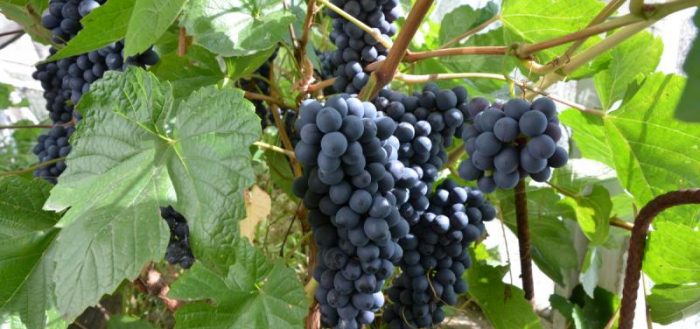
Grapes in Siberia are not fiction. Gardeners in the harsh region successfully grow a thermophilic culture, getting good yields of delicious berries. The secrets are simple: choosing the right varieties or hybrids, regular care, following the rules of agricultural technology.
It is advisable for beginners to start growing with small planting areas, observing the condition of plants in specific conditions. Over time, experience will come, their developments will appear. In the meantime, it is recommended to listen to the advice of specialists, detailing how to grow grapes in Siberia.
Content
- 1 Grapes in Siberia: the specifics of the region
- 2 Schemes of Siberian Viticulture (CERs)
- 3 Siberian varieties
- 4 Choosing a place to land
- 5 Dates of planting seedlings
- 6 Preparation of seedlings and cuttings
- 7 Planting cuttings and seedlings
- 8 How to plant grapes?
- 9 Growing options
- 10 Grape formation
- 11 Grape care
- 12 Hardening of Siberian varieties
- 13 Shelter of grapes in Siberia
- 14 Reviews
- 15 Conclusion
Grapes in Siberia: the specifics of the region
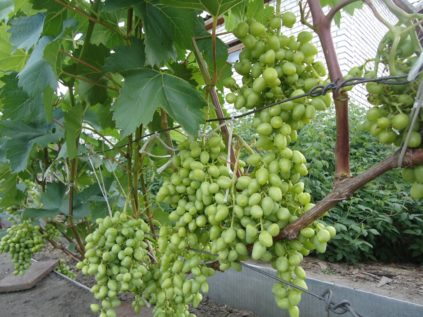
Siberia is a territory with its own characteristics, due to the short, often cool summer season. Southern cultures feel uncomfortable here, therefore, they often recommend replanting in open ground to replace with planting in greenhouses.
A huge region is characterized by a difference in climatic conditions. So, in Western Siberia, continentality is sharply expressed, while the climate of Eastern Siberia depends on the features of the relief. The soils of the East Siberian regions are based on the deep layers of permafrost; in the West Siberian territories podzolic, sod-podzolic, and also tundra soils prevail.
Chernozems freeze deep in winter, in the spring, with the arrival of warm days, they require a significant period of time for thawing. These factors must be considered when selecting grape shapes.
Previously, the main mistake of Siberian winegrowers was the use of agricultural techniques used for vineyards in the southern regions of Russia. Few people understood how to grow grapes in Siberia, what subtleties to pay attention to first of all. The choice of varieties was wrong, landed early, but not frost resistant varieties, which led to the death of landings.
The results came after the appearance of grapes capable of adapting to the conditions of the short summer season, resistant to cold and return frosts.
The first successes were achieved in Altai, in the famous Belokurikha. A talented breeder V.K. Nedin worked there, whose work later served as the basis for the cultivation of Siberian varieties. Later, Biysk gardeners received high yields, who bred and used frost-resistant varieties with excellent taste. In the early 70s, amateur gardener R.F. Sharov founded a school for winegrowers in the region. Thanks to the works of this person, more than three dozen hybrid forms of culture have been created for the Siberian regions.
Practice has shown that grafted grapes grow better, while rootstocks are used as rootstocks. wild species plants from the Far East or varieties of Canadian, North American selection.
Schemes of Siberian Viticulture (CERs)
The experience of breeders was generalized, systematized, and two systems for growing crops were developed.
Scheme number 1
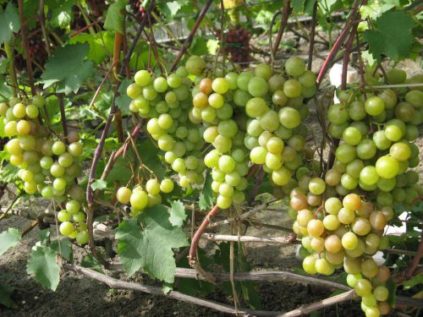
The basis is the grafting of selected early varieties onto specially selected stocks of grapes taken from the natural growing conditions. Crop was given by plants, grown from cuttings Amur varieties of culture. Technology Features:
- when planting, they dig trenches;
- the vine is not tied up until the onset of stable heat;
- the load on the shoot is determined only after the end of the frost.
In the territories beyond the Ural Mountains, it is difficult to predict the return of cold weather in the spring, so you should not risk and normalize the load in advance. Bushes form on vertically mounted supports. Be sure to leave spare eyes in case of freezing of bushes.
During the growing season do without treatments for diseases and pests. The explanation is simple: there are no outbreaks of dangerous infections in the region, therefore they are content only with loosening the soil around the bushes. For vaccinations, only stocks resistant to low temperatures are used.
Scheme No. 2
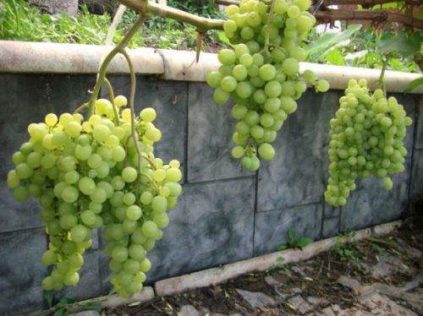
Grow a culture from cuttings. Early varieties are planted, harvesting their own planting material in the fall. In winter, they keep it in the cellar, dig it under cover along with adult bushes. Features:
- when cultivated on fertile, chernozemic soils, they do without digging holes, making fertilizing;
- on loam, clay or sandy soils dig small holes for planting;
- there is no spring pruning (except for the removal of diseased branches).
Landing in small holes, trenches or boxes is common. On depleted soils, dig holes, make fertilizers. In the same way, as in scheme No. 1, they do not spray from diseases. Only weeds are removed from the aisles and the soil is slightly loosened.
Before wintering, they cover the vine in trenches, grooves, under arcs. Wintering conditions are determined by cultivation technology, as well as specific climatic conditions. In practice, gardeners use different technologies, combine schemes, choosing suitable options for themselves. They do not exclude top dressing, treatment of plantings, and culture is hardened to obtain a better result.
Siberian varieties
Several dozen grape varieties intended for cultivation in Siberian regions have been bred. These are early and mid-season varieties adapted to the characteristics of the regional climate.
Delight
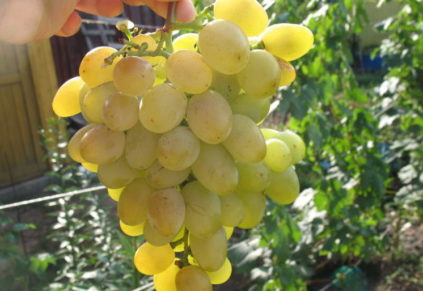
To -25 ° C frost withstands the variety Rapture. This beautiful grape with large, reddish-colored berries fell in love with Siberian gardeners. Forms clusters of 700-850 grams. Unpretentious and productive look.
Riddle
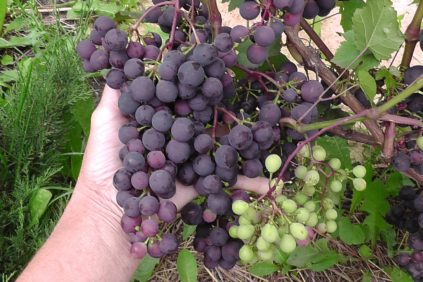
With proper care, it will give Riddle grapes an excellent harvest. In the open air it ripens in about 110-115 days, in shelters - 14-16 days earlier. Brush - up to a kilogram in weight, with dark blue juicy berries.
Beauty of the North
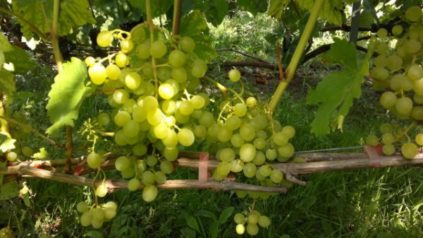
Not so easy breeders called this grape. Its berries are really beautiful and tasty. Small brush, up to 250-300 grams. The berries are pink-white, juicy. The bushes withstand frosts down to -28 ° C. Harvest, not moody.
Tukai
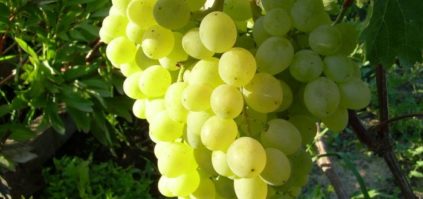
On tall bushes, cylindrical brushes are formed. Weight - 700-800 grams. Berries are white, with a stone. The “minus” of Tukay is the susceptibility to disease even in conditions of Siberian cold. But this variety is not afraid of frost, it quickly grows in the spring after freezing.
In addition to these varieties, varieties and hybrid forms of Pink Timur, Kodryanka, Harold have proven themselves well.
Choosing a place to land
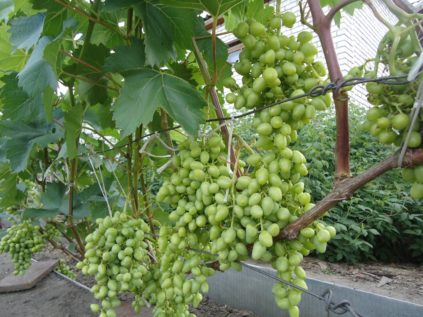
In regions with a short summer season, particular importance is attached to the choice of a landing site. For the "southerner" determine the solar areas, preferably with a cover in the form of a blank fence from the north. Avoid places with the presence of winds, lowlands, as well as areas with close passage of groundwater.
Dates of planting seedlings
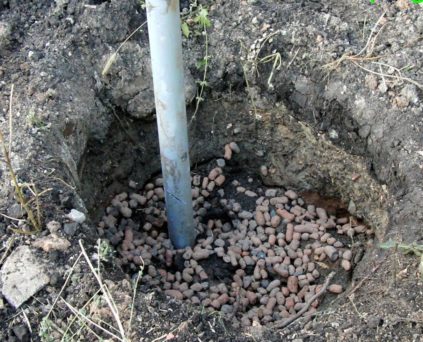
Time depends on the weather of a particular area.Usually stable heat arrives in the region in the second half of May, for gardeners a hot season begins.
The air warms up to + 15 ° C, so nothing threatens the bushes. Seedlings are planted on a cloudy day so that the bright rays of the sun do not burn the bushes. For the first time, plants shade.
Preparation of seedlings and cuttings
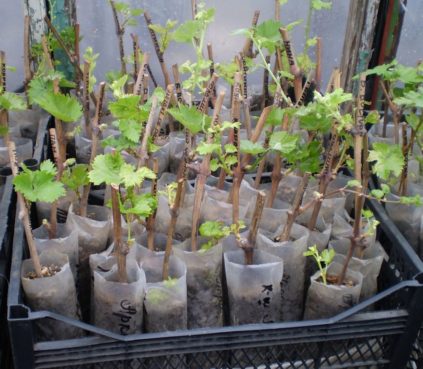
It is convenient to plant grape bushes in containers, since their roots are closed. But such planting material is not always available from gardeners. More often bushes are sold with open roots. Plants purchased in the fall store winter in the basement or cellar.
When planting such grapes, preparatory work is carried out:
- roots are cut (up to 8-10 cm);
- the grapes are soaked with roots in solutions with stimulants (sodium humate, Kornevin);
- before planting, dip roots in a mixture of clay.
Additionally, a little diluted mullein is added to the clay creamy mixture.
Planting cuttings and seedlings
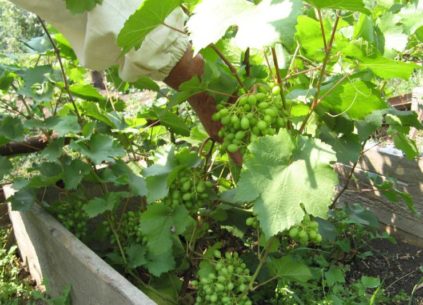
Grapes are planted upon the onset of heat, heating the air to + 15 ° C ... + 18 ° C. Different methods are used, taking into account the characteristics of specific varieties, the conditions of the site and their own capabilities.
Landing in the box
Planting is common in boxes made of boards. The boxes are deepened into the ground, the walls are coated with clay. The method is effective in regions with long winters, where the soil warms up slowly after the snow melts.
Inside the baskets, heat accumulates in the soil, the seedling begins to grow and bear fruit earlier.
Trench Landing
Landing in trenches that protect the root system and shoots from freezing is popular. The distance between the edges of the trench below is about a meter, between the upper edges - 1.3-1.5 meters. Depth - 50 cm. To strengthen the walls use boards or slate. The installation of supports is done taking into account the height of the trench.
The supports are placed above the soil level to prevent moisture from precipitation or snow from getting between the walls. Trenches are a good protection of grapes from damage by rodents.
Landing in the pit
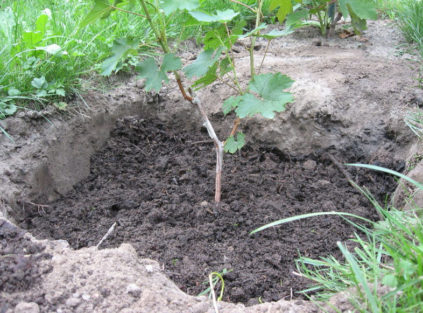
The traditional option is used on chernozems, poor soils. A nutrient mixture, drainage (slag, gravel, fragments of brushwood) are laid in the pit.
Mixture: compost, potash and phosphorus components, ash. Before planting, it is advisable to grow bushes at home. In February or March, they are planted in prepared containers, and only then, when it is warm, they are transferred to ridges. The method is suitable for grapes grown from cuttings, as well as for bushes purchased in the fall.
How to plant grapes?
A number of gardeners prefer to cultivate grapes only on ridges. Others believe that in regions with such harsh and unpredictable conditions, the best option is to use a greenhouse. The choice is determined by the possibilities of the gardener, the budget, the availability of space for equipment of high shelters.
In the open ground
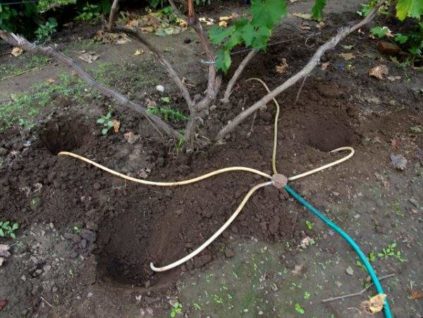
On the site choose a place, seedlings are planted strictly vertically. When planting in trenches, plants are not buried. Be sure to straighten the roots and water the bushes with warm water.
Mulch inhibits weed growth and retains heat and moisture in the soil. Rotten plant residues emit carbon dioxide, which is necessary for photosynthesis.
In the greenhouse
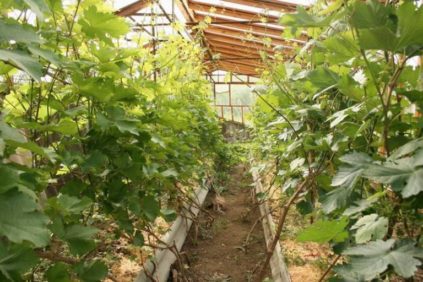
For grapes you need to put a special greenhouse:
- shelter height - not less than three meters;
- equip a drip irrigation system, vents for ventilation.
When grown in greenhouse shelters, manual pollination is organized for all cultivars. Also, plants need mandatory spraying from aphids, leafworms, and numerous diseases. In shelters, in a comfortable microclimate, insidious fungi develop rapidly, which threatens with a loss of yield.
Bush load
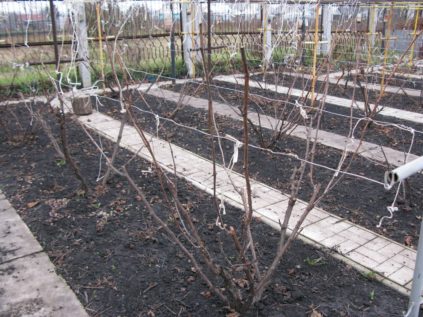
Early grape varieties are highly fertile.In regions where temperature changes are a common occurrence, a crop with a full load on the vine does not have time to ripen. To get the crop on time, bushes are rationed.
In the first two years, plants grow without human intervention, on their own. Next, cut off the extra shoots, forming a load. In the third season, 10-12 eyes are left for the summer period. In the third year, the load in the fall is increased to 20-25 hands. For plants with small clusters and small berries, the load is done more.
Pruning
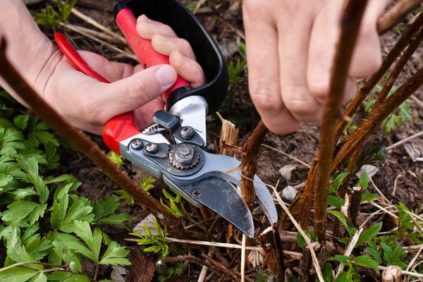
Feature of pruning grape bushes in Siberia: carried out only in autumn, in two stages. In late spring or early summer, it is recommended to remove weak, diseased shoots. Autumn pruning is required, as thick, with numerous shoots bushes are difficult to shelter for the winter, and in the spring under cover they more often wither.
The first stage: remove extra shoots after picking berries, but before dropping leaves. Thinning the base of the bush, crooked and deformed shoots, green vine.
The second stage: pruning - before shelter for the winter, when the plant discards foliage. Create a fruit link, forming a bush from the bottom. Oriented on the diameter of the shoots, leaving 10 to 12 eyes. Plants for the autumn after collecting berries have accumulated a sufficient supply of elements, without difficulties they will survive the winter.
Growing options
Due to the special climatic conditions, winegrowers practice different cultivation schemes.
On the trellis
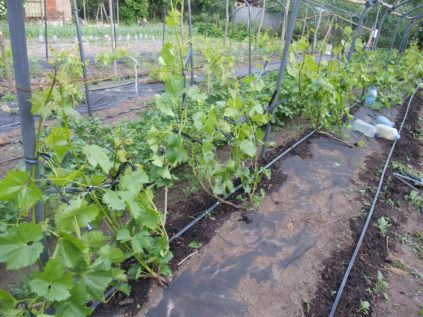
The traditional option is the use of trellises, but at the same time additional devices are equipped to protect against possible cold snap.
- Install special foil screens for heat storage.
- They put roofs above the trellises, which trap heat from the ground.
- Tighten the ends in the rows of film.
Supports in these cases hold the vine, and shelters protect against unforeseen cataclysms of nature.
Practiced two options for trellis culture growing:
- rows are arranged from east to west, trellis racks are equipped in one plane, bushes cover the walls of outbuildings or a fence;
- with a free landing, the rows are arranged from south to north, trellis are mounted in two planes.
The shape of the bush is cardiac radiation, as the most suitable for the harsh conditions of the region.
In barrels
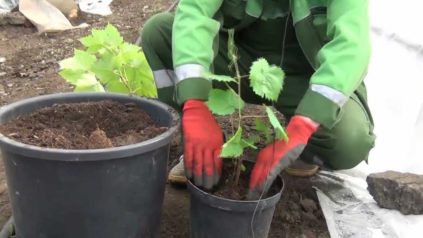
The technology of cultivation of thermophilic plants in barrels is widespread. Vines in winter are reliably closed from the cold, do not freeze.
In preparation for wintering, barrels are placed in trenches or transferred to cold rooms (under a canopy, in cellars). In the spring, containers of grapes are taken out to greenhouses, and only then to ridges under the open sky. The volume of barrels for such landings is 70-80 liters. After about 6-8 years, grapes from barrels are transplanted to the ridges.
In the heat, it is advisable to cover the plants from the sun, organizing a light partial shade. The method is time-consuming, but if you want and have the time, it is used to grow undersized varieties.
Containers
The option is similar to landing in trenches, boxes. Plastic containers are suitable, the volume is 20-30 liters. Before wintering, the tanks are dug up, the vine is bent, they are carefully covered.
Grape formation
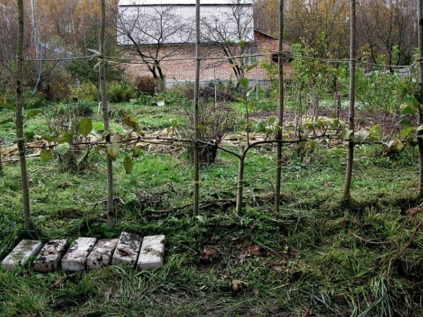 In addition to choosing a method of growing, they are determined with the formation of bushes. The fan version is best shown when the bush grows without a stem. In cold climates with short summers for such landings easier to careharbor for the winter.
In addition to choosing a method of growing, they are determined with the formation of bushes. The fan version is best shown when the bush grows without a stem. In cold climates with short summers for such landings easier to careharbor for the winter.
In the first year, the plant is not cut, leaving all branches. The next year, the central shoot is cut, leaving two mittens (branches) below. Form on a pair of knots, leave four kidneys.So gradually grow the bush to four sleeves (usually this happens in the third year). The form is a fan, hence the name of the method.
Fruits on the bushes last year's vine, which is cut after harvest. Therefore, when forming and pruning, it is taken into account that the annual fruiting shoots should grow by spring every season on the plant. It is also important that these vines have a replacement for next year.
Create a fruiting shoot (pruning about 6-12 kidneys) and a replacement knot with a pair of three eyes. The yield of the bush is determined by the correctness of pruning, varietal characteristics, plant age and its strength.
Grape care
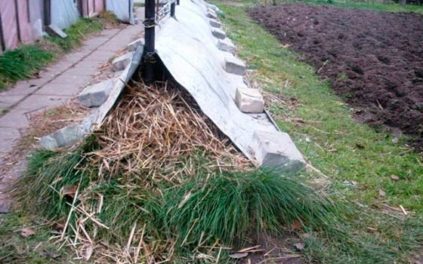
To grow grapes in Siberia for beginners is not so difficult, planting and care include a set of standard techniques:
- watering;
- top dressing;
- treatment for infections.
The difference is that in Siberia the causative agents of dangerous diseases are not so active, so there are enough preventive measures.
Top dressing
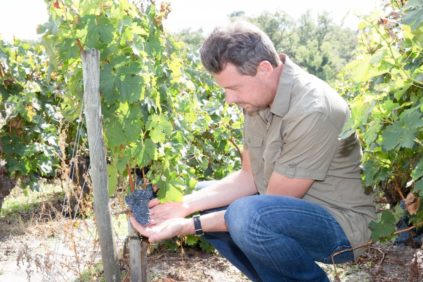
For the first three years, grapes do not need additional nutrition. The seedling is fed by a mixture laid in a pit (trench, box). From the fourth year in the spring and early summer, organic matter (humus, manure) is introduced. Nitrogen fertilizers are standardized, as they cause a powerful growth of the vine and prevent it from ripening normally. Instead of manure, it is useful to add formulations with humic acids. They help improve soil quality, increase the immunity of grapes. Since mid-summer, complete complex fertilizers with a minimum nitrogen content or only potassium-phosphorus additives have been added.
The culture responds well to the introduction of ash, potassium monophosphate, compounds from the Kemir series.
Watering
The volume and timing of irrigation depends on the soil, weather conditions, plant conditions, planting method. In the open, it is enough to water the grapes 3-4 times a season. Bushes are irrigated in trenches at a rate of 50-60 liters per square meter. With a separate landing in the pits, they are guided by the state of the vines.
In shelters, culture requires more frequent watering. Irrigation is not allowed during the period when the culture is gaining color, as well as during filling and ripening of fruits.
In the fall, water-loading irrigation is organized so that the bushes are better prepared for wintering and have moisture reserves. Volume at a time - 100-120 liters (adult bushes), 60-70 liters (young vines).
Disease prevention
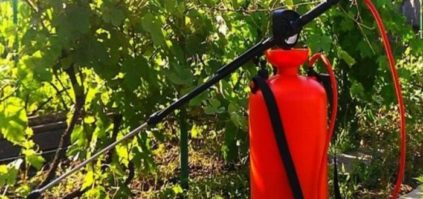
The hard work of Siberian winegrowers is facilitated by the fact that pathogens of dangerous diseases do not survive in cold weather and short summers. A minimum of treatments is a serious plus in agricultural technology, because the harvest is environmentally friendly, without harmful toxins.
Prevention measures:
- site cleaning after harvesting and leaf fall;
- selection of varieties resistant todiseases and pests;
- timely pruning, removal of diseased shoots;
- fertilizer dosage, a minimum of nitrogen in the fertilizing;
- compliance with the distance during landing.
In the spring, it is useful to spray the vineyard with Bordeaux liquid (1%), a solution of potassium permanganate (, 5%). If the first signs of oidium or mildew are noticed, promptly process the bushes Tiovit Jet, Ridomil or Topaz (according to instructions).
Effectively for prevention, spray the culture in early summer with a solution of Actellik. Siberian winegrowers use biological products suitable for processing at any phase of the growing season. Among them: Baikal EM-1, Shine and others.
Hardening of Siberian varieties
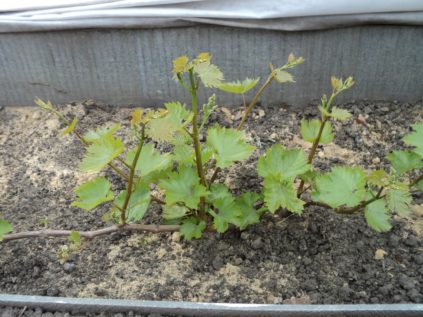
Growing grapes in greenhouses is easier, but under such conditions, plants lose their immunity, get used to the heat. Gardeners with experience believe that planting grapes on ridges in the open air contributes to hardening of the culture and its adaptation to local conditions.
Such plants are resistant to temperature changes, seasonal weather fluctuations. They survive the winter easier, give strong and healthy seedlings.All season to keep the vine under cover is impractical.
Shelter of grapes in Siberia
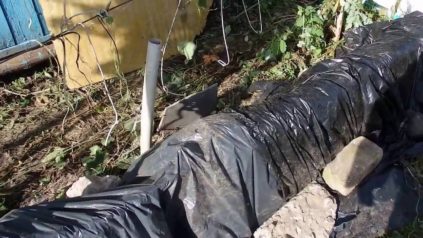
Legends make up the severity of the Siberian winter, so grapes are not grown here without shelter. From mid-October, bushes begin to prepare for wintering, focusing on weather conditions. Early shelter leads to the escaping of shoots, rotting of grapes. Therefore, they wait for temperature indicators of about 0 degrees and only after that they bend the vine.
Cut the branches in advance, remove them from the supports. The bushes must be dry, moisture is not allowed on the plantings. Shelter planting on a sunny day, gently stacking the shoots on the boards. You can not lay shoots on the ground.
Top cover with non-woven material, then lightly sprinkle with earth and cover with spruce branches. Everything else will finish the snow. In winter, the amount of snow cover on the shelters is controlled. During snowless winters, snowdrifts are poured, and special barriers are set up to hold the snow cover.
As soon as the snow melts in spring, the shelters slightly open. If a film was used, then from the ends open the edges of the material for ventilation. They do not completely remove the shelter, waiting for the vine to adapt to heat. In mid-April, arcs with a film are placed over the grapes. Temporary shelter is removed by the end of spring, when frost disappears in the region, and the air warms up well. After this, the branches are carefully lifted to the supports, tied up.
Reviews
Alexander, Barnaul
I have been growing grapes for more than ten years. The most productive varieties are Tukay, Szabo, and Katun Muscat. It grows in my ridges, next to it is a barn, so the plantings are closed from the winds. Fuss a lot, cultivating varieties takes time, last year also appeared mildew. But all difficulties are surmountable, but how good the grapes are harvested, not like a store.
Marina, Omsk
I only grow a few bushes in the greenhouse. She retired and wanted to grow grapes in our climate. I read literature, watched a video. After a successful experience with watermelons and melons, I took up this culture. I received several brushes in the third year, I have a grade Riddle. I plan to expand the landing, I will try open transplant.
Conclusion
Growing grapes in Siberia for beginners may seem difficult. Mastering agricultural technology is required gradually, and there results will come. Obtaining a high crop will allow compliance with care methods, the correct selection of varieties, your own desire.




 Non-covering winter-hardy grape varieties for Moscow region
Non-covering winter-hardy grape varieties for Moscow region How to keep the vine in winter
How to keep the vine in winter When can I transfer grapes to another place in the fall
When can I transfer grapes to another place in the fall How to cover and prepare grapes for the winter in the suburbs
How to cover and prepare grapes for the winter in the suburbs